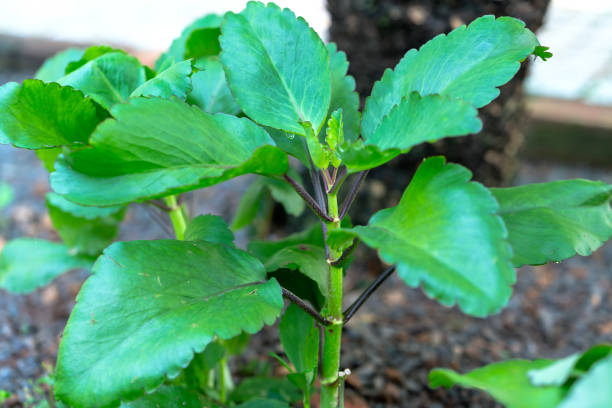

Kalanchoe pinnata (Lam.) Pers.
|
It is commonly known as Amar poi and belongs to the Crassulaceae family. Leaves are cooked for consumption. Kaempferol 3-O-rutinoside, Quercetin 3-O-L-rhamnopyranoside, Kaempferol 3-O-α-rhamnopyranoside, Octadecanoic acid and Squalene are some of the bioactive compounds found in this plant. Aqueous extract of K. pinnata has promising immunomodulatory activity. In vivo treatment with aqueous extract reduced the levels of IL-5, IL-13 and TNF-α in sensitized and challenged mice. Mode of Consumption : Cooked |
| Plant Details | Agro-climatic Zone | Vernacular Names | Pictures |
| Scientific Name: Kalanchoe pinnata (Lam.) Pers. Family: Crassulaceae J.St.-Hil. Class: Magnoliopsida Order: Saxifragales Genus: Kalanchoe Adans Fruiting Season: Through out the year Parts: Leaves |
|
Assam : Dupor-tenga, Pategoja Bihar : Amar poi Delhi : Amar poi Haryana : Amar poi Jharkhand : Amar poi Kerala : Elamarunna Madhya Pradesh : Amar poi Odisha : Patargaja Rajasthan : Amar poi Tamil Nadu : Runakkalli Uttar Pradesh : Amar poi Uttarakhand : Amar poi West Bengal : Kop Pata |
 Plant |
| Compound/Extract | Activity | Mode of Action | Marker/References |
| Aqueous extract | Immunomodulatory | Aqueous extract (400 mg/kg) reduced parasite-specific IgG serum levels and depressed IL-4 production, but not IFN-γ and NO in BALB/c mouse model infected with Leishmania chagasi. | IgG, IL-4, IFN-γ, and NO[1] |
| Aqueous extract | Immunomodulatory | Aqueous extract reduced production of OVA specific IgE antibodies, reduced eosinophilia, and decreased production of the IL-5, IL-10 and TNF-α cytokines. | IgE, IL-5, IL-10, and TNF-α[2] |
| Aqueous extract | Immunomodulatory | In vivo treatment with aqueous extract reduced the levels of IL-5, IL-13 and TNF-α in sensitized and challenged mice. | IL-5, IL-13, and TNF-α[3] |
| Aqueous extract of leaf | Anti-inflammatory | Leaf aqueous extract decreased the levels of TNF-α, IL-1β and increased levels of the anti-inflammatory cytokine IL-10 in the mouse paw tissue. | TNF-α, IL-1β, and IL-10[4] |
| Ethyl acetate fraction of leaves | Anti-inflammatory, Antioxidant | Ethyl acetate fraction is able to inhibit the overexpression of the IFN-α which is produced by the dendritic cells in Pristane-induced Lupus-like Disease Mice. | IFN-α[5] |
| Aqueous extract | Anti-inflammatory | Aqueous extract prevented lupus nephritis symptoms in the kidney by reducing proteinuria level and better tissue structure. | [6] |
| Dichloromethane fraction | Antidiabetic | The dichloromethane fraction demonstrated excellent insulin secretagogue action and the fasting blood glucose values were reduced to 116 mg/dl from 228 mg/dl on treatment with 10 mg/kg body weight of DCM fraction. | [7] |
| Aqueous extract of leaf | Antihypertensive | Aqueous extract of leaf increased glutathione(GSH), superoxide dismutase(SOD) levels which was reduced and increased levels of creatinine, bilirubin and aspartate aminotransferase (AST) in high salt-hypertensive rats. | GSH, SOD, and AST[8] |
| Major Class | Metabolites (Content of bioactives: mg/100g Fresh Weight) |
| Glycoside | Bryophyllin A: [6] |
| Effect | Observation | DOI |
| Disease | Formulation | Reference | Author | TKDL |
| Information from Wealth of India | Reference |
|
CSIR(1948).The Wealth of India, Raw materials,Vol.-I ,P.233, New Delhi, India |
| 4.2, 4.2.1, 4.2.1.1, 4.2.1.3, 4.2.2.8, 4.2, 4.2.1, 4.2.1.1, 4.2.1.3, 4.2.2.8 |
| CSIR-North East Institute of Science and Technology, Jorhat-6, Assam, India
CSIR-Institute of Himalayan Bioresource Technology, Palampur-61,Himachal Pradesh, India |